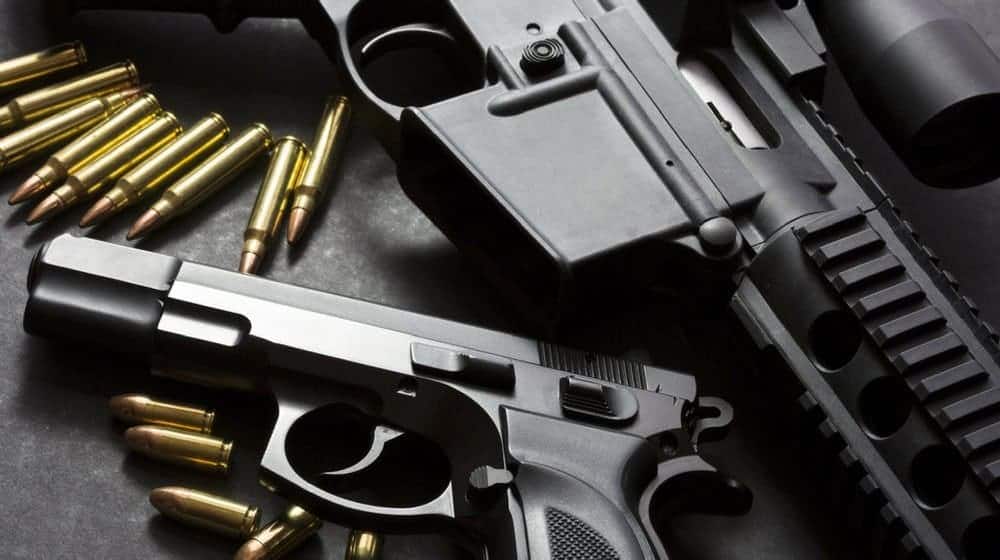In the current media coverage of firearms, it’s really common to hear terms related to guns being used incorrectly. Though we may chuckle when they do it; it’s actually a big problem.
Misunderstanding creates more fear around a hobby and right which had been a cornerstone of our country since its founding. To take control of the narrative and change public perception, we need to spread the correct information where we can. Little by little, we can make a difference.
That’s why we compiled this list of 10 misused gun terms. Check your understanding and help inform the public to promote a safe understanding of firearms.

#1 CLIP AND MAGAZINE
This is one of the most mistakes you hear when people talk about guns. To many, “clips” and “magazines” are the same thing.
You know what, it’s honestly understandable. Clips and magazines are both involved in reloading firearms, but they serve different purposes. The television and film industries are largely to blame for this.
You know when you’re watching TV and the hero runs out of ammo. There’s that awesome moment when they turn to their buddy ask, “Clip?”
Then the partner tosses them a rectangular box containing ammo. The hero slaps into his gun with a manly snap, and then he continues to shoot the bad guys.
Sadly, experienced gun users probably cringe at this. We know the difference, and soon you will too.
Clips are devices that hold ammo in a way that makes it easy to load into magazines. These clips let the firearm user reload magazines faster into the gun.
Magazines are the rectangular box-shaped tools that are loaded with ammo and are inserted into the gun. Magazines are the way the ammo is fed into the chamber as you fire.
Clips are still used, but not as often by the casual gun user. The military carries them often to make reloading magazines as quick as possible in live-fire situations.
#2 HANDLE AND GRIP
Maybe it’s just me, but this one gets on my nerves. “Handle” and “grip” are often the same or similar parts of many everyday items. Knives, scissors, wrenches, and other tools all have handles and grips, and they both refer to parts of the tool you put your hands on.
When it comes to guns, nothing could be farther from the truth. Most of the time, when you’re talking about grip or handle they actually mean grip.
Grip refers to the part of the gun (most often with handguns) where you place your hands to hold in preparation to fire. The grip helps you fire, aim, and use the trigger and safety.
Handles are the part of a gun (most often larger machine guns and other heavy weapons) that you can hold onto to carry the gun easier. This isn’t the part you hold onto to fire the weapon at all. It’s purely about transportation.
#3 ASSAULT RIFLE/WEAPONS AND SEMI-AUTOMATIC WEAPONS
Due to the media coverage against the AR-15, this confused term is rising in popularity and is the most potentially damaging to firearms in general. The unfortunate mass shootings have caused these terms to rise with a completely wrong idea attached to them.
Most AR-15s and other weapons like this are actually semi-automatic. To the public, this means that with one pull of the trigger the gun can spray bullets with reckless abandon.
This is not the case. Semi-automatic weapons, like the AR-15, fire one bullet with one pull of the trigger.
Assault rifles refer to guns that have the select ability to be both semi-automatic and fully automatic. Fully automatic does refer to the ability to fire all ammo with one pull of the trigger.
These weapons are actually Federally regulated because they are more dangerous. However, the guns the average American uses are actually semi-automatic and not dangerous when used properly.
#4 ACCURACY AND PRECISION
To some, the difference between “accuracy” and “precision” are minimal and don’t make much difference. If you’re looking to become a better shooter, the difference is actually quite important.
Accuracy refers to how close your shot is to the target. You fire one shot right in the bullseye. Your shot was accurate.
Precision is about how tight your grouping of shots are. You fire five times and the grouping of those shots is within a small circle. Your shooting is precise.
In the worst case scenario, if you fire ten rounds and none are near the target or each other, you’re not accurate or precise. You need to put in some time at the firing range with a coach, my friend.
Ideally, your ability to fire is both accurate and precise. To be both, you’d need to place a consistent number of shots close to your target. If you can’t, think about what you need to improve on.
While this is the goal, you’re not going to be both without some serious practice. If your shooting is accurate but not precise, you should practice your procedure for shooting. There’s something going wrong with your habits.
I recommend paying extra close attention to the shots that get close to the target. Take note of what your body was doing when you made that shot. Try to replicate the exact things that happened each time you fire because this can improve your precision.
If you’re precise but inaccurate, it may be worthwhile to check out your sights.
#5 SUPPRESSOR AND SILENCER
This one’s a little tricky. The term “silencer” is not accurate at all, but it exists in common use. However, suppressors are real and accurately describe what’s happening.
Suppressors are tools that attach to the barrel of your gun to lessen the volume of a gunshot. They don’t completely eliminate the sound but control the amount of air released to limit the sound.
Silencers are born from the film and television industry. Just screw on a “silencer” and your gunshots completely silent. This kind of thing doesn’t exist.
Here’s where it gets tricky. The ATF defines silencers as a tool designed to lessen the report (sound) of a firearm. These are regulated by the federal government.
However, up until recently, the term suppressor was actually used to describe the same thing, according to the American Suppressor Organization. It’s all back and forth.
Which term should you use then? While either may work, I recommend using “suppressor” because it’s more accurate.
#6 HANDGUN AND PISTOL
Some people use these terms freely; others fight tooth and nail that they’re separate. While it’s ultimately up to you, I prefer to go the way of clarity.
Handguns should refer to all guns that are held in your hand when you fire. You don’t brace it against your shoulder like rifles or shotguns. It seems obvious, but we need to start with this definition.
Pistols are a subset of handguns that are semi-automatic (as in, not revolvers). The ammo is fed to the chamber through the grip using a piston (thus pistol). To sum up, all pistols are handguns, but not all handguns are pistols.
Despite the fact that the National Firearms Act defines them as the same thing, some state laws actually separate them as we’ve described above. For example, Texas law separates revolvers from pistols.
#7 CARTRIDGE, BULLET, AND CALIBER
There may be no better way to tell a fake gun enthusiast from an actual gun user than how they use the terms cartridge, bullet, and caliber. These words are used so often interchangeably and incorrectly. Let’s define these clearly.
Cartridges are the ammo you load into your gun. It sits in the magazine (check above) before being fired. Cartridges contain all parts needed to fire a projectile including:
- Projectile
- Case holding all parts
- Propellant (gunpowder)
- Rim
- Primer
Bullets are another word for the projectile that’s sent out of the barrel of your gun. Bullets are in cartridges but aren’t dangerous on their own. It’s the other parts (namely the primer and propellant) that expel the bullet at deadly speed.
Caliber is the measurement of the bullet’s diameter. This can be measured in inches and millimeters. In general, the larger the caliber the more powerful the bullet when fired from the cartridge (see what I did there).
Don’t embarrass yourself by going to buy “bullets” from the store when you actually want “cartridges.” Take the time to educate your friends too, so they don’t embarrass you.
#8 POCKET PISTOL AND SUBCOMPACT PISTOL
Here’s another set that keeps getting switched up with another. Can you guess which term is more official?
Subcompact pistols are smaller versions of a full-sized pistol. The barrel is shorter, and, sometimes, the width of the gun is slimmed down.
Subcompact pistols serve the purpose of being smaller guns that are easier to conceal and carry without being noticed.
Pocket pistols is an informal term that talks about any gun small enough to be holstered in a pocket. Sometimes this can refer to a subcompact pistol if it’s small enough and your pockets are big enough. Other times, the pistol is specifically designed to be extra small without having a larger model.
#9 MACHINE GUN AND FULLY AUTOMATIC
Machine guns and fully automatic guns don’t always mean the same thing. This is another case where the two words are close but different enough to make a difference.
Fully automatic refers to the firing mode of a gun. With one pull of the trigger, multiple bullets are fired one at a time.
Machine guns are fully automatic, and the 1934 National Firearms Act lumps all machine guns and fully automatic guns into the same, regulated category. The more specific use of the word, “machine gun,” refers to a gun designed for sustained and rapid automatic fire.
Historically, machine guns are portable or mounted. They aren’t considered accurate, some can fire up to 300 bullets in one minute. They often used long belts of ammo to fire as many as possible at the enemy.
Machine guns were and are largely in use by the military. They’ve fallen out of favor for the more accurate semi-automatic weapons or 3-shot burst rifles (which are still considered fully automatic).
All machine guns are fully automatic; not all fully automatic weapons are machine guns. It all depends on how long and fast they are designed to be fire for.
#10 ACCIDENTAL DISCHARGE AND NEGLIGENT DISCHARGE
Knowing the difference between accidental and negligent discharge can change the public’s perception of firearm safety. When the media uses the term “accidental discharge” incorrectly, it’s reinforcing the idea that guns are inherently dangerous. In fact, the majority of “accidental” discharge covered aren’t accidents at all.
Accidental discharge is when your gun goes off unintentionally due to an unforeseen and basically unpreventable mechanical failure. This happens rarely. If it does happen, don’t panic and keep the gun pointed away from people and nearby objects.
Negligent discharge is what happens most of the time. This is when the gun fires due to unsafe use or poor care. The key difference is that negligent is preventable by proper safety and accidental is not.
When you hear of someone’s gun going off in their holster at a store, this is likely negligent because the gun owner may have left the safety on. While this still isn’t good by any means, calling it by what it takes the burden of guilt of the firearm itself and puts where it belongs: on the poor choices of the gun owner.
CONCLUSION
We hope you enjoyed reading our list of 10 misused gun terms. Maybe you found that you use a term incorrectly, maybe not. But you can use this information to correct common misunderstandings about guns.
By spreading this knowledge, you’re doing your part in making sure that firearms stay an important right in our country. On top of that, no one’s going to judge you for using the wrong word.
Have fun, and keep on shooting!
If you enjoyed this article you’ll probably like these:


